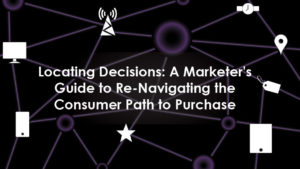 Blis, the global pioneer in advanced location data technology, launched the findings of an in-depth study exploring consumer behaviours leading up to and during the point of purchase.
Blis, the global pioneer in advanced location data technology, launched the findings of an in-depth study exploring consumer behaviours leading up to and during the point of purchase.
Detailed in a new report entitled Locating Decisions: A Marketer’s Guide to Re-Navigating the Consumer Path to Purchase, the research shows consumers have begun to adopt a non-linear path to purchase that encompasses multiple start points dotted across channels and platforms.
Just five years ago, the majority of shoppers placed TV ads as the primary source of knowledge for new product discovery, closely followed by friends and family. Blis’ research suggests that this has flipped almost entirely: fewer than one in four respondents indicated they rely on TV for new product discovery today, instead favouring the store as a source of inspiration.
Almost one-third of consumers reported that in-store browsing remains their primary product discovery channel, followed by targeted online/mobile advertising. And, while most of a consumer’s research still happens online via a laptop/desktop or mobile phone from 6pm onwards, data shows more than half of shoppers will visit a store at least two to three times before making a sizeable purchase.
“In spite of all of the time and money being invested in new channels like video, influencers, UGC and online, for the majority of consumers discovery starts where we’ve traditionally known the journey to end: the store,” said Gil Larsen, VP Americas at Blis. “What’s perhaps even more eye opening is how likely shoppers are to spend more once they’re in store. Where consumers begin their discovery journeys significantly impacts how they spend their dollars, and there’s an incredibly compelling narrative developing for retailers on how to rethink in-store strategies using location insights and construct a new path to purchase compass to navigate multiple consumer touchpoints.”
 While, at first glance, in-store browsers look to pose a problem for brands trying to market to and influence them using technology, a significant percentage (36%) browse both mobile and physical stores at the same time to check for prices and product availability presenting a huge opening for retailer messaging. One out of four respondents indicated an offer from another retailer offering a bonus gift or “buy one get one” type offer would change their mind, and 20% would be swayed by a targeting online/mobile ad offering a price reduction on a similar product elsewhere.
While, at first glance, in-store browsers look to pose a problem for brands trying to market to and influence them using technology, a significant percentage (36%) browse both mobile and physical stores at the same time to check for prices and product availability presenting a huge opening for retailer messaging. One out of four respondents indicated an offer from another retailer offering a bonus gift or “buy one get one” type offer would change their mind, and 20% would be swayed by a targeting online/mobile ad offering a price reduction on a similar product elsewhere.
“At every moment, especially in store, there are still ample opportunities to sway consumers even if they are at the point of purchase. Brands that aren’t taking advantage of this additional opportunity to persuade consumers are missing out on critical touchpoints within the purchase journey,” added Larsen. “By understanding where and what consumers are browsing via location and behavioural data, brands can create more targeted and highly personalised ads, increasingly the likelihood of conversion.”
As discussed in Blis’ previous whitepaper Unlocking The New Consumer Hierarchy Of Needs, brands are still coming to terms with the new retail landscape. This research paper takes it a step further by offering guidance on how these “Conscious Consumers” are experiencing the customer journey and when/how brands should be interacting with potential shoppers, especially through the use of location insights.
More like a web than a traditional path, the complexity and lack of causal progression within this new shopper journey presents untold challenges for brands. When navigated correctly, the myriad touchpoints offer new ways to influence consumers and, ultimately, sell to them, both on their terms and wherever they happen to be.
Blis conducted market research through AYTM, surveying 2,000 consumers across the U.S. at every socioeconomic level, to uncover shopper preferences and how they like to best interact with brands.
Source: Blis

You must be logged in to post a comment Login